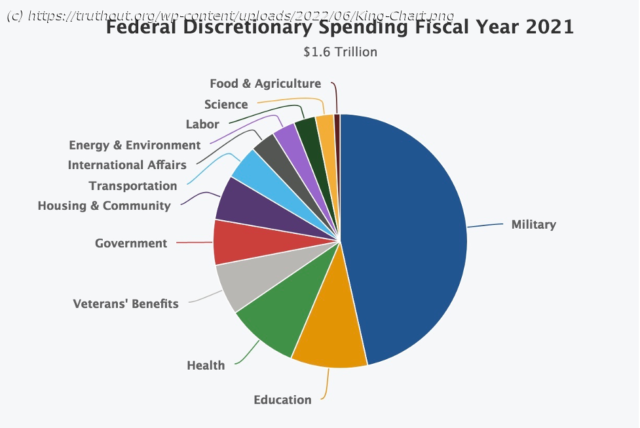More than half of the income taxes remitted to the U.S government are spent on Pentagon accounts.
If United States taxpayers knew that half the income tax dollars they sent to the Internal Revenue Service every year was being spent on weapons, war and war preparation, political support for such programs might significantly decline. Unfortunately, no agency of the federal government communicates to taxpayers how the Congress spends their money. Massachusetts State Rep. Carol Doherty and State Sen. Jo Comerford have introduced a bill into the state legislature, the Taxpayers’ Right to Know Act, supported by Massachusetts Peace Action and allies. The bill instructs the state treasurer to communicate to Massachusetts taxpayers how the state and the federal government spend their income tax dollars. This is a first step toward federal legislation bringing transparency to the Congressional Discretionary Budget. Organizers hope to promote such bills in other states, given the roadblock against such open and honest reporting from the federal government. These are small but important first steps in focusing attention on income taxes being used to finance corporate drivers of dangerous and costly nuclear weapons purchases, especially in the context of Russia’s invasion of Ukraine. Purchasing weapons and military services with taxpayer dollars has always been, and continues to be, a highly profitable endeavor for defense contractors. But it is in a real war, such as in Ukraine, that such profiteering truly thrives. President Joe Biden recently sent to Congress his budget proposal for 2023. It included an astounding $818 billion for Pentagon and military expenditures. This is more than half the income taxes citizens send to the federal government each year, and a more than $31 billion increase over the already bloated fiscal year 2022 Pentagon budget. It also more than the defense budgets of the eight next biggest military spenders put together, including Russia, China and India. The proposed increase for 2023 was cloaked in the flag of support for Ukrainians, but make no mistake, most of this bloated budget was in the pipeline years back, prior Russia’s invasion of Ukraine. In late April, the president announced a plan to spend another $33 billion for weapons and military supplies for Ukraine. On May 19, Congress quickly passed an even larger $40 billion appropriation, with unanimous Democratic support. This included some humanitarian aid but was primarily for the $20 billion in weapons and weapons support, including Patriot anti-aircraft missiles, Javelin anti-tank missiles and artillery. This is closer to the true war budget, with built-in assumptions of material loss and need for replacement. Such expenditures can be even more lucrative than the base Pentagon budget. The weapons shipments to Ukraine will be considered justification for further purchases to maintain the U.S.’s stockpile, according to The New York Times:
The purchase of weapons and supplies in preparation for war and for maintenance of forces in the field is a singularly lucrative and profitable business because of the cost and nature of most contracts; the guarantee of Pentagon purchases; and the protection from offshore competition, such as industries in China, India or Mexico. During “peacetime,” missiles, artillery shells, airplanes and armored vehicles need to be replaced at a relatively slow rate. This limits the weapons sales market. That is part of the reason for pressure from the industry for “new” weapons to increase their markets. Beating the drums of war will enhance the corporate bottom line, as noted by Raytheon CEO Greg Hayes commenting on the benefits to their business of the Ukraine crises:
Too often during Pentagon budget debates, foreign policy “concerns” obscure the driving imperative coming from the weapons industries. As The Nation pointed reported, at the onset of the invasion of Iraq,
Historians of World War II, often fail to emphasize the role of the major Japanese and German major manufacturing industries in driving their country’s war efforts. As long as the war continued, these businesses were guaranteed continuing weapons sale to their governments and military forces. U.S. naval historians note that the Japanese Kamikaze attacks were very wasteful, since both plane and pilot were lost and neither could engage in further sorties.
Home
United States
USA — Financial Defense Contractors Are Using Tax Dollars to Profit Off War in Ukraine






